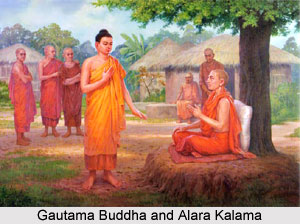 Bodhisattva i.e. Buddha in his early stage of life needed a philosopher and guide who would show him the way to Dhamma that will lead him to nirvana. Alara Kalama was then a well-known ascetic who had conquered the seven out of eight stages of jhana or yagna. He imparted the knowledge of Nothingness or akincannayatana jhana to his pupils. Teachers like Alara Kalama were rare in those days who would guide people to the path to attain the jhanic achievements. In those days he was quite popular as a teacher.
Bodhisattva i.e. Buddha in his early stage of life needed a philosopher and guide who would show him the way to Dhamma that will lead him to nirvana. Alara Kalama was then a well-known ascetic who had conquered the seven out of eight stages of jhana or yagna. He imparted the knowledge of Nothingness or akincannayatana jhana to his pupils. Teachers like Alara Kalama were rare in those days who would guide people to the path to attain the jhanic achievements. In those days he was quite popular as a teacher.
Theravada Buddhist literature does not mention Alara Kalama. Lalitavistra, northern School of Buddhism, mentions him and states that Alara dwelled in Vaishali. He had 300 students at his center. According to Alara, his doctrine could be picked up quickly by an intelligent man. Moreover the practicality of the doctrine depended upon the pursuer. The path to pursue Dhamma has to be realized and understood by the individual himself. Such tenets were later incorporated in Buddhism according to which an individual must apply his own logic to understand various principles.
The conspicuous feature of Alara Kalama`s teachings was that he did not follow any religious text or a guru. In fact he taught what he himself had realized through his achievements. This aspect of Alara`s teachings impressed the Bodhisattva. He soon learnt the Dhamma, which led to the state of Nothingness. Alara Kalama was all praise for Gautama and expressed his desire for the Bodhisattva to lead the center jointly with him.
However the path Alara Kalama did not lead Siddharth to nirvana. Hence he soon left the center. It was from here that Gautama Buddha went to Udaka.




















